Cucumbers growing in a greenhouse and outdoors have to be cared for differently. How to properly grow this crop indoors and outdoors, read on this page.
| Content:
|
Caring for cucumbers in a greenhouse and outside is different. In protected soil, crops have increased requirements for care and maintenance; here they are much more susceptible to pests and diseases.
Caring for cucumbers in a greenhouse and in open ground, what is the difference?
The main differences are as follows.
- As a rule, long-climbing, weakly branching varieties are grown in a greenhouse. Neither bush cucumbers nor highly branched cucumbers are suitable for indoor soil. In open ground you can grow any varieties and hybrids intended for such cultivation.
- Cucumbers can be planted in a greenhouse to obtain an early (May-June) and late (September-October) harvest. Cucumbers are grown in open ground only in summer; neither early nor late greens can be obtained here.
- In closed ground, cucumbers grow in one stem. On the street they are not pinched, allowing them to curl in all directions.
- It is necessary to monitor the humidity in the greenhouse. In the open air it is impossible to influence it in any significant way.
- It is advisable to plant cucumbers alone in protected ground to avoid the occurrence of common diseases with other greenhouse crops. On the street, compatible crops are often planted with cucumbers, whose leaf secretions prevent the cucumbers from being affected by diseases (onions, garlic), or shade the plantings (corn).
- In closed ground, weeds are trimmed; they cannot be weeded, since the root system of cucumbers can be damaged. In open ground, overgrown plants themselves will choke out any, even the hardiest, weeds, so borage, as a rule, is free of weeds.
- Greenhouse cucumbers are much more often affected by diseases than outdoor ones.
- In open ground, the crop has virtually no pests, while in a greenhouse it is often damaged by omnivorous pests.
In addition, the care requirements of varieties and hybrids are somewhat different. Hybrids are more demanding in terms of fertilizing and watering than conventional varieties.
Caring for cucumbers in a greenhouse
Cucumbers are planted in the greenhouse as early as possible, as soon as the ground warms up to 17°C to a depth of 20-25 cm. The second planting date is the beginning of August, when the cucumbers are already growing outside. With late summer sowing, the harvest is harvested at the end of September.
Either parthenocarpics or self-pollinating cucumbers are suitable for greenhouses. They do not require bees to set greens.
- In self-pollinating cucumbers have practically no male flowers. Pollen is carried by the wind. It can be transferred from the stamens to the pistil of the same flower, or it can get to another flower, either on the mother plant or on any other. In any case, pollination occurs and the ovary is formed.
- Parthenocarpics set without pollination at all. Their fruits have no seeds or only rudimentary ones.
The main thing when caring for greenhouse cucumbers is watering, fertilizing and air humidity.
Sowing dates for greenhouse cucumbers
Greenhouse cucumbers are usually planted in 2 terms:
- in spring to obtain early products;
- towards the end of summer for the autumn harvest.
The exact timing depends on the weather and region. In the south, seeds are sown in the greenhouse in mid-to-late April, in the north - in the second ten days of May. To obtain autumn greens in the north and in the middle zone, cucumbers are planted in a greenhouse in the second ten days of July.
Fresh cucumbers can be harvested in September. In the south, the planting date is mid-to-late August; greens will appear in October. But late summer sowing is too risky, especially when grown in unheated greenhouses. In the case of a cold, rainy autumn, the risk of being left without a harvest is very high.
No matter when greenhouse cucumbers are grown, they always need warm soil. Therefore, in the greenhouse they arrange a manure bed, or, in extreme cases, a compost bed. These components are biofuels and produce a large amount of heat, which contributes to the normal development of plants even in very cold weather.
Sow seeds only in warm soil, otherwise they will not sprout. The soil temperature at a depth of 15-20 cm should be at least 17°C. To speed up its warming up in the spring, water it with boiling water 2-3 times every other day.
Neighbors of cucumbers in the greenhouse
Most often, dachas have 2-3-bed greenhouses in which crops are grown together. To cultivate cucumbers together with other greenhouse crops, it is necessary to take into account the care requirements of these crops.
Cucumbers require high humidity, shade from direct sun and a desirable air temperature of 23-28°C.
- Cucumbers with tomatoes. Incompatible neighborhood. Although crops tolerate each other well, they have completely different care requirements from sowing to harvest. Tomatoes require dry air, drafts and high light. When grown together, it is the tomatoes that suffer the most and a good harvest is not seen. In addition, cultures have common diseases.
- Cucumbers with peppers. An even less successful combination Pepper requires dry air; it does not like long ventilation, which cannot be avoided when growing with cucumbers. Peppers do not grow well at high temperatures, but cucumbers respond well to them. Peppers are affected by the cucumber mosaic virus, although to a lesser extent than tomatoes.
- Cucumbers with eggplants. These crops are most suitable for growing together. Eggplants love high air humidity, frequent ventilation, and high temperatures.
Still, it is better to grow cucumbers in single plantings. It should also be taken into account that crops are grown in greenhouses only to obtain early and late harvests (with the exception of the northern regions). Therefore, after harvesting cucumbers, before planting seedlings of other greenhouse crops, the soil must be prepared again. After all, neither peppers, nor tomatoes, nor eggplants tolerate manure or fresh compost, so it will have to be removed from the garden bed.
How to care for greenhouse cucumbers
Cucumbers are grown in greenhouses in one stem, so that there are no thickets below and a favorable environment for the development of diseases.
Formation of plants
Hybrids. After the fourth leaf appears, the crop is tied to a trellis. When side shoots appear, pinch them off. Buds and flowers are removed from the axils of the first 4 leaves. If they are not plucked, the growth of the plant will be delayed and the overall yield will decrease.
The lowest flowers take almost all the nutrients, but the greens produced are too loose, and in bee-pollinated varieties these flowers do not set at all. The main stem is twisted weekly around the twine. After the 5th leaf, the emerging side shoots are pinched above the 2nd leaf. And greens form on these short lashes.
After the 11th leaf, 3 nodes are left on the side shoots, and the top is pinched. When the cucumbers reach the trellis, the vines are thrown over it and the top of the main stem is pinched. The side shoots that begin to grow at the end of the main stem no longer blind, but provide the opportunity to grow freely.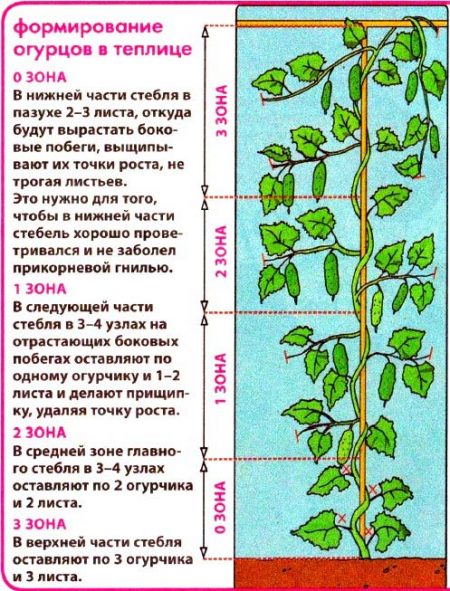
Varieties formed differently. They produce predominantly male flowers on the main stem, while female flowers appear mainly on the side shoots.Above the 4th leaf, the main stem is pinched, and then the nearest bud produces a side shoot that replaces the main stem. It will have significantly more female flowers.
Further pinching is the same as for hybrids: all the resulting side shoots become blind after the 2nd leaf. When the whip is thrown over the trellis, the shoots are no longer torn off, giving them the opportunity to branch.
When caring for a cucumber bed, thickening should not be allowed, otherwise continuous thickets will form and there will be practically no flowers and fruits.
Feeding - this is the main thing in caring for cucumbers from sowing to harvesting. Cucumbers are extremely gluttonous. To obtain a harvest outside the season, fertilizing is done once a week. For summer cultivation - once every 10 days. Hybrids require much more nutrition than varietal plants, so they are fed once every 5-7 days.
To provide cucumbers with everything they need, you should always have on hand an herbal infusion, an infusion of ash (100 g / 10 l), a complete complex fertilizer, kalimag and, of course, an infusion of manure.
Root feeding alternates with foliar feeding, and organic feeding with mineral feeding. The feeding rate for hybrids is 3-4 times higher than for varietal plants.
Watering carry out only with warm, settled water. Plants need high soil moisture, so water them at least 3 times a week, and daily on hot days. On cold and cloudy days, the crop is watered very sparingly. Watering is carried out in the first half of the day, they can be combined with fertilizing.
Shading It is desirable for greenhouse cucumbers. To do this, a mosquito net is thrown over the trellis. It is especially necessary to shade cucumbers during the midday hours.
Harvesting carried out once every 2-3 days. Overgrown greens inhibit the emergence of new ovaries.No matter how well the plant is fed, it gives all its nutrients only to the seed fruit. The quality of the harvest and the duration of fruiting depend on the timely collection of greens.
How to care for cucumbers in open ground
Caring for cucumbers in open ground is much easier than in a greenhouse. Nowadays, cucumbers are more often grown outdoors than in protected ground.
All types of cucumbers are suitable for open ground: bee-pollinated and hybrids, bush and strongly climbing (when grown on a trellis). The basic rule when sowing crops is to plant bee-pollinated plants and hybrids separately. Cross-pollination of these species should not be allowed, otherwise the quality of the harvest will be extremely low, and the harvest itself will be small. In small areas it is better to plant either only varieties or only hybrids.
Place for cucumbers
The crop grows well under trees, then there will be no need for artificial shading, and the vines have room to curl. The only thing that needs to be done is to clear the soil of weeds, since cucumbers cannot be weeded. When pulling out weeds, the roots of cucumbers are easily damaged and the plants die. As a last resort, the weeds are trimmed. As borage grows, it will choke out any weeds.
Place for cucumbers is allocated where pumpkin crops did not grow last year, but early cabbage, onions, legumes or strawberries were grown.
Manure beds for plants are prepared only in the northern regions on cold, poorly heated soils. In all other cases, manure is applied in the fall, covering it to a depth of 20 cm.
Sowing time
Outdoors, cucumbers are grown by direct sowing of seeds in the ground. Seedling cultivation is now practically not used, since there are a lot of attacks, and the yield is lower.
The determining factor for sowing is soil temperature. If it is below 17°C, then you cannot sow cucumbers, because it is too cold for the crop and the seeds will die. To warm up the earth as quickly as possible, it is covered with a film.
Before sowing, the seeds are usually not germinated, but only soaked for 20-30 minutes in warm water and sown immediately.
The sowing time in the northern regions is June 5-15, in the middle zone - the end of May, in a cold, protracted spring - the beginning of June. In the south, seeds are sown in early May.
The seeding depth is 1.5-2 cm, the distance in the row is 25-40 cm. It depends on what kind of cucumbers are grown. Bush plants need less space, their feeding area is small, so sowing is carried out every 25-30 cm. Medium-climbing, weakly branching cucumbers are planted after 30 cm, strongly climbing varieties after 40 cm.
In cold weather, crops are covered with any covering material (film, lutarsil, hay).
Care after emergence
After the emergence of seedlings, covering material is left only in cold weather and in the event of night frosts. During frosts, it is better to cover the seedlings with a double layer of thin covering material than with one thick layer (for example, thick film). It is very good to use hay against night frosts by mulching cucumbers with it. Under such shelter, young plants can withstand temperatures down to -6°C without much damage.
7 days after germination, the cucumbers have their first true leaf. Subsequent leaves are formed at intervals of 5-8 days.
After the appearance of the real leaf, the main care consists of watering and fertilizing. The fertilizer consumption rate for hybrids is 4-5 times higher than for bee-pollinated varieties. Plants are fed in the same way as in greenhouse conditions.
At an early age, cucumber beds are not weeded due to the fragility of the root system of the crop. If the plot is overgrown with weeds and the soil is compacted, then the weeds are trimmed. You can loosen the seedlings at a distance no closer than 25-30 cm from the plant. If the soil is very dense and swollen, then to improve aeration it is pierced with a pitchfork to the full depth of the tines at a distance no closer than 20-25 cm from the plant.
Caring for a fruit-bearing plantation
Cucumbers in open ground They are either grown up (horizontally) or tied to a trellis.
When grown horizontally care comes down to regular watering and fertilizing. Cucumbers do not form; the vines grow freely in all directions. Only in bee-pollinated varieties can you pinch the main stem after the 4th leaf to stimulate branching and the formation of female flowers.
Watering is carried out according to the area, since after the plants have grown it is impossible to find the main stem. Water consumption rate 20-25 l/m2.
With vertical When growing the plant, after the 4th leaf, tie it to twine and point it upward. All shoots, buds and flowers are removed from the axils of the lower 4 leaves. The remaining side lashes are allowed along the trellis. The main fruiting of cucumbers in open ground always occurs on vines of 3-5 orders.
The following indicators are optimal for cucumbers:
| Indicators | During the day | At night | |||
| Clear | Mainly cloudy | ||||
| Air temperature before fruiting, °C | 24-26 | 22-24 | 18-19 | ||
| Air temperature during fruiting, °C | 26-28 | 24-26 | 20-22 | ||
| Soil temperature, °C | 25-27 | 24-26 | 22-24 | ||
| Relative humidity, % | 80-85 | 75-80 | 75-80 | ||
| Soil moisture, % | 70-90 | 60-70 | |||
If the street is very hot and the humidity is low, then to increase it, the cucumbers are watered with rain early in the morning. Plants should be shaded several hours after sunrise to allow water to dry out.Otherwise, there will be burns on the leaves and holes will appear.
Difficulties and problems when growing cucumbers
Sown seeds do not germinate
If they are viable, then the absence of seedlings indicates that they were sown in cold soil and died. Cucumbers are sown only when the soil warms up to at least 17°C.
Bee-pollinated varieties have a lot of barren flowers and practically no ovaries
- Use for sowing fresh seeds. The largest number of female flowers in varietal cucumbers is formed when they are sown 2-3 years after harvest.
- The main stem was not pinched. It always produces male flowers. Female ones appear on the lashes of the 2nd and subsequent orders.
Greenhouse cucumbers develop small holes on the upper leaves
These are sunburns caused by dew drops falling from the greenhouse roof in the morning. To prevent burns, cucumbers are shaded and well ventilated in the morning.
The greens thicken near the stalk, the opposite end tapers, resembling a beak. Leaves are light and small
Lack of nitrogen. The crop is fed with manure (1 l/10 l of water), grass fertilizer (1 l/5 l of water) or nitrogen mineral fertilizers (1 tbsp/10 l of water).
The greens are pear-shaped, and the edges of the leaves have a brown border.. Potassium deficiency. Fertilizing with potassium fertilizer that does not contain chlorine: 3 tbsp/10 l of water. You can feed with infusion of ash - 1 glass per plant.
Leaves curl up. Lack of phosphorus. Top dressing with superphosphate: 3 tbsp/10 l of water.
The leaves have a marbled tint - lack of magnesium. Feeding with kalimag. You can use dolomite flour for feeding, which contains magnesium (1 cup/10 l).
Yellow-green leaves - general lack of microelements. Fertilizing with any microfertilizer.
Arched greenies
- Abundant watering after a long absence of moisture in the soil. The crop needs frequent, abundant watering, and the soil should not dry out.
- Sudden changes in day and night temperatures.
- Watering with cold water.
- Pollination of hybrids by insects. This often happens if bee-pollinated varieties and hybrids are grown together. To avoid this, the distance between these types of cucumbers must be at least 600 m. In summer cottages, where this is not possible, either varieties or hybrids must be grown.
Cucumbers are bitter
Green vegetables contain the element cucurbitacin. If not properly cared for, its concentration increases sharply and the fruits become bitter. The appearance of bitterness in fruits is always associated with stressful situations for cucumbers. Currently, varieties have appeared that do not contain cucurbitacin, which means they will not taste bitter even under extreme growing conditions. The main causes of bitter greens are as follows.
- Sudden change in temperature.
- Prolonged cold snap. In this case, to prevent the greens from becoming bitter, if possible, cover the beds with a double layer of lutarsil, throwing it over a trellis.
- Uneven watering or watering with cold water.
Zelentsy do not grow
Cucumbers grow at night, and if they don't grow, it's too cold at night. The beds should be covered with covering material at night.
Lack of ovaries
- Sowing fresh seeds of bee-pollinated varieties. On plants grown from such seeds there are almost no female flowers, but only exclusively male ones.
- Temperature above 36°C. In such conditions, the plant goes into survival mode and has no time to set greens. When the temperature drops, the fruits will appear.
- Excess nitrogen in fertilizing. Cucumbers actively grow leaves and weakly set greens.It is necessary to reduce the proportion of nitrogen and increase the dose of potassium in the feeding. With a high nitrogen content, it accumulates in greens, which is dangerous for human health.
- Lack of pollinating insects. This often happens when planting bee-pollinated varieties in a greenhouse. To obtain a harvest, you have to manually pollinate the flowers.
The ovaries turn yellow and fall off
- Watering with cold water. Especially if water from a well from deep soil horizons is immediately used for irrigation.
- In bee-pollinated and self-pollinated plants, this happens if fertilization has not occurred. Most often this happens in greenhouses at temperatures above 36°C or humidity above 90%.
- Prolonged cold spells and rains also prevent pollination because bees cannot fly. In self-pollinating varieties, pollen in such weather becomes heavy and loses volatility.
- In parthenocarpics, the ovaries turn yellow and fall off during the bud type of fruiting due to lack of nutrition. 1-2 greens grow in a bunch, the rest fall off. In order for all the ovaries in the bunch to develop, it is necessary to increase the dose and amount of fertilizing.
The lower leaves turn yellow and dry out
It's quite normal. A fruiting plant has lower the leaves always turn yellow. In general, when growing cucumbers in a greenhouse or on a trellis, it is recommended to remove the 2 bottom leaves every 10 days to make it easier for the plant to feed the ovaries.
Wilting cucumbers
If this is not associated with a disease of the root system, then it is a consequence of prolonged drought and lack of watering. The plants need to be watered.
Growing cucumbers is actually not as difficult as it seems at first glance. But they require systematic painstaking care.
You might be interested in:
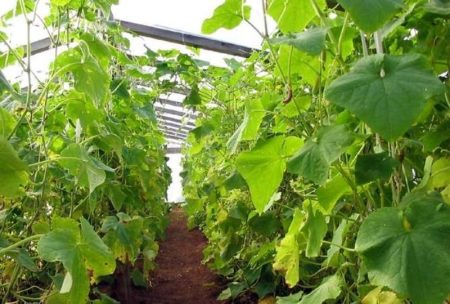
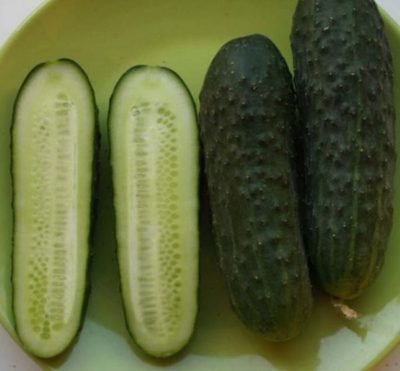
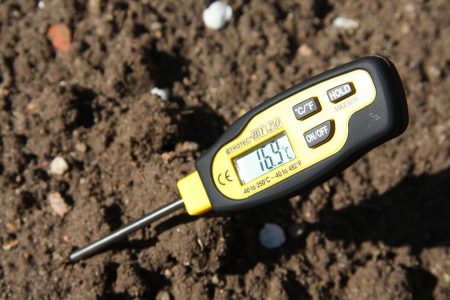
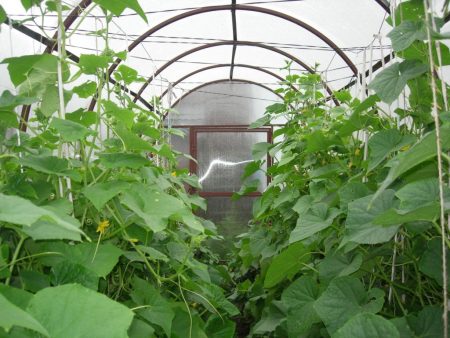
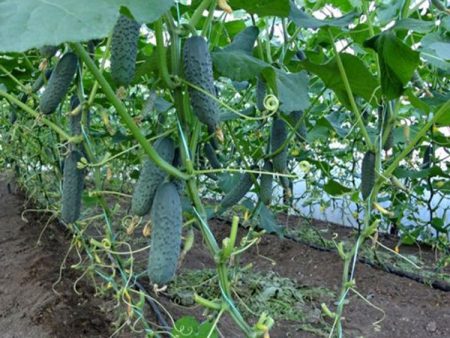
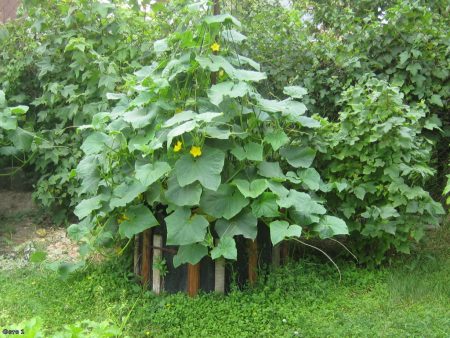
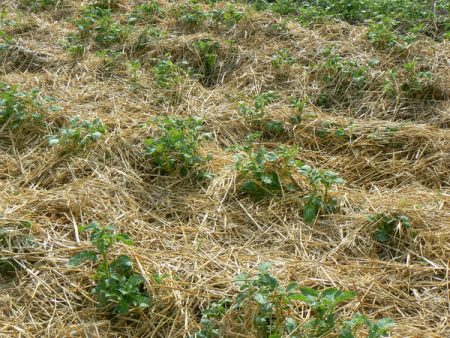
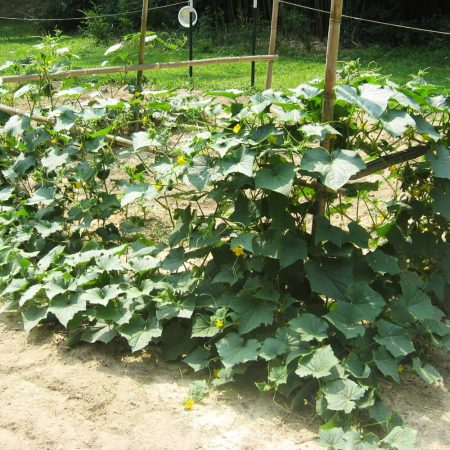
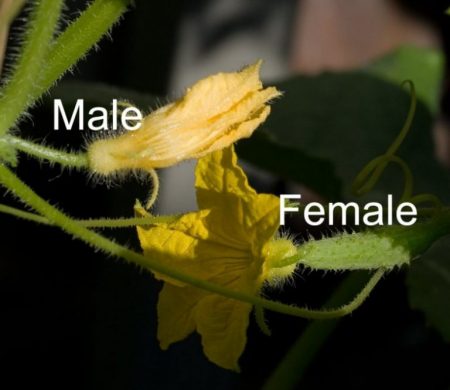
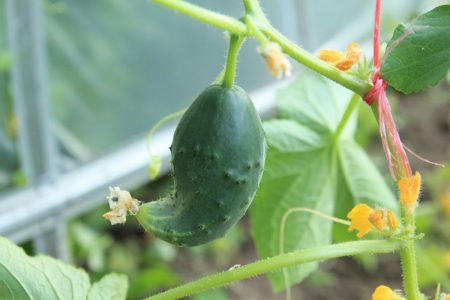
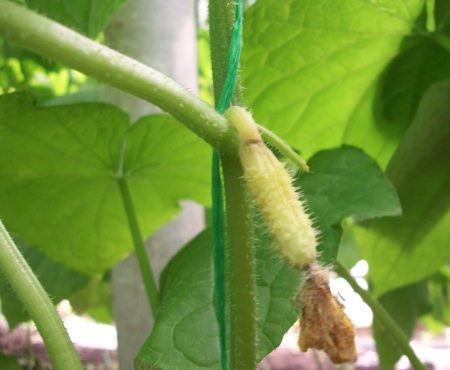

 CUCUMBERS NEVER GET SICK, I'VE BEEN USING ONLY THIS FOR 40 YEARS! I SHARE A SECRET WITH YOU, CUCUMBERS ARE LIKE THE PICTURE!
CUCUMBERS NEVER GET SICK, I'VE BEEN USING ONLY THIS FOR 40 YEARS! I SHARE A SECRET WITH YOU, CUCUMBERS ARE LIKE THE PICTURE! You can dig a bucket of potatoes from each bush. Do you think these are fairy tales? Watch the video
You can dig a bucket of potatoes from each bush. Do you think these are fairy tales? Watch the video
 How our fellow gardeners work in Korea. There is a lot to learn and just fun to watch.
How our fellow gardeners work in Korea. There is a lot to learn and just fun to watch. Eye trainer. The author claims that with daily viewing, vision is restored. They don't charge money for views.
Eye trainer. The author claims that with daily viewing, vision is restored. They don't charge money for views. A 3-ingredient cake recipe in 30 minutes is better than Napoleon. Simple and very tasty.
A 3-ingredient cake recipe in 30 minutes is better than Napoleon. Simple and very tasty. Therapeutic exercises for cervical osteochondrosis. A complete set of exercises.
Therapeutic exercises for cervical osteochondrosis. A complete set of exercises. Which indoor plants match your zodiac sign?
Which indoor plants match your zodiac sign? What about them? Excursion to German dachas.
What about them? Excursion to German dachas.